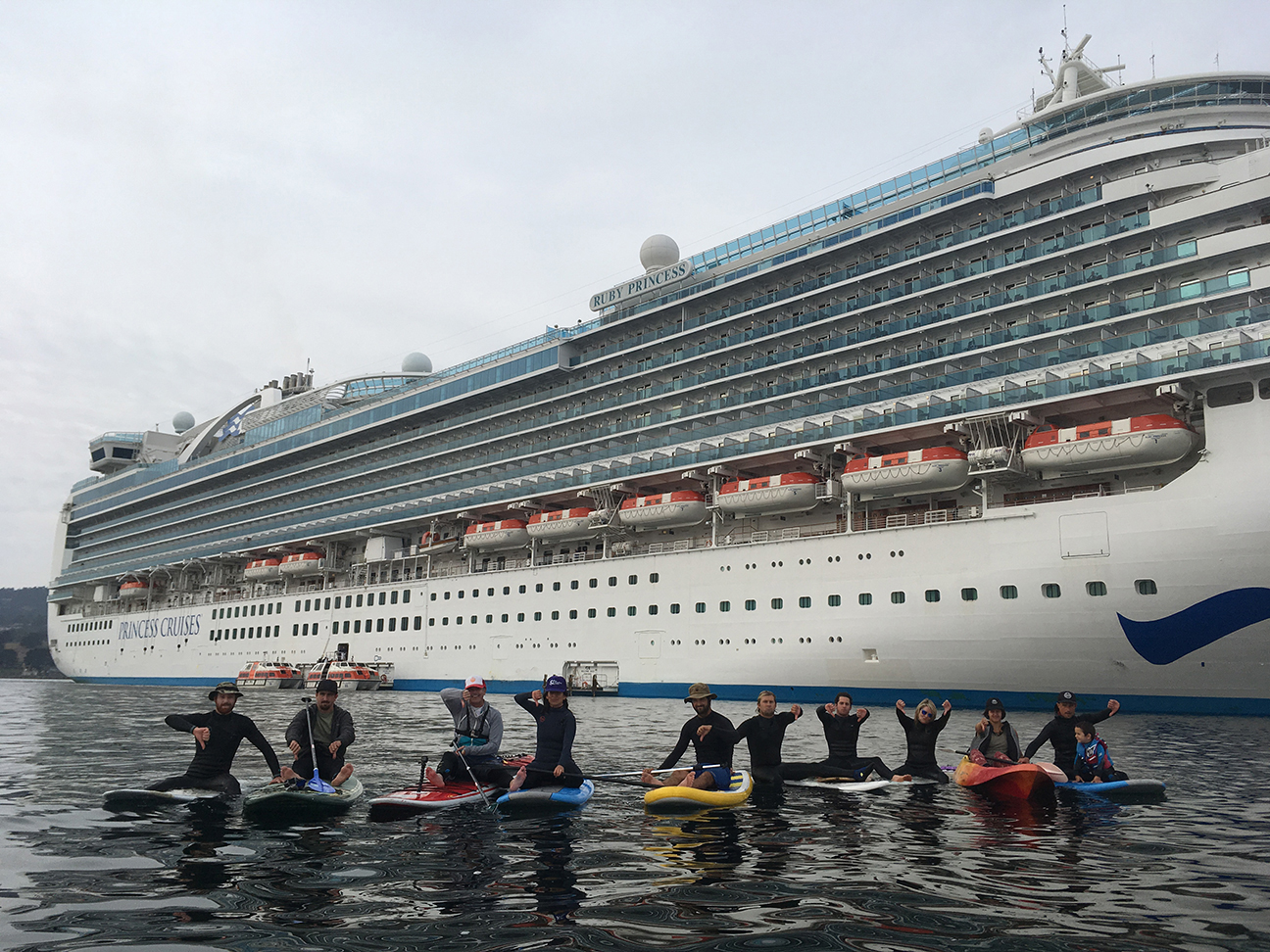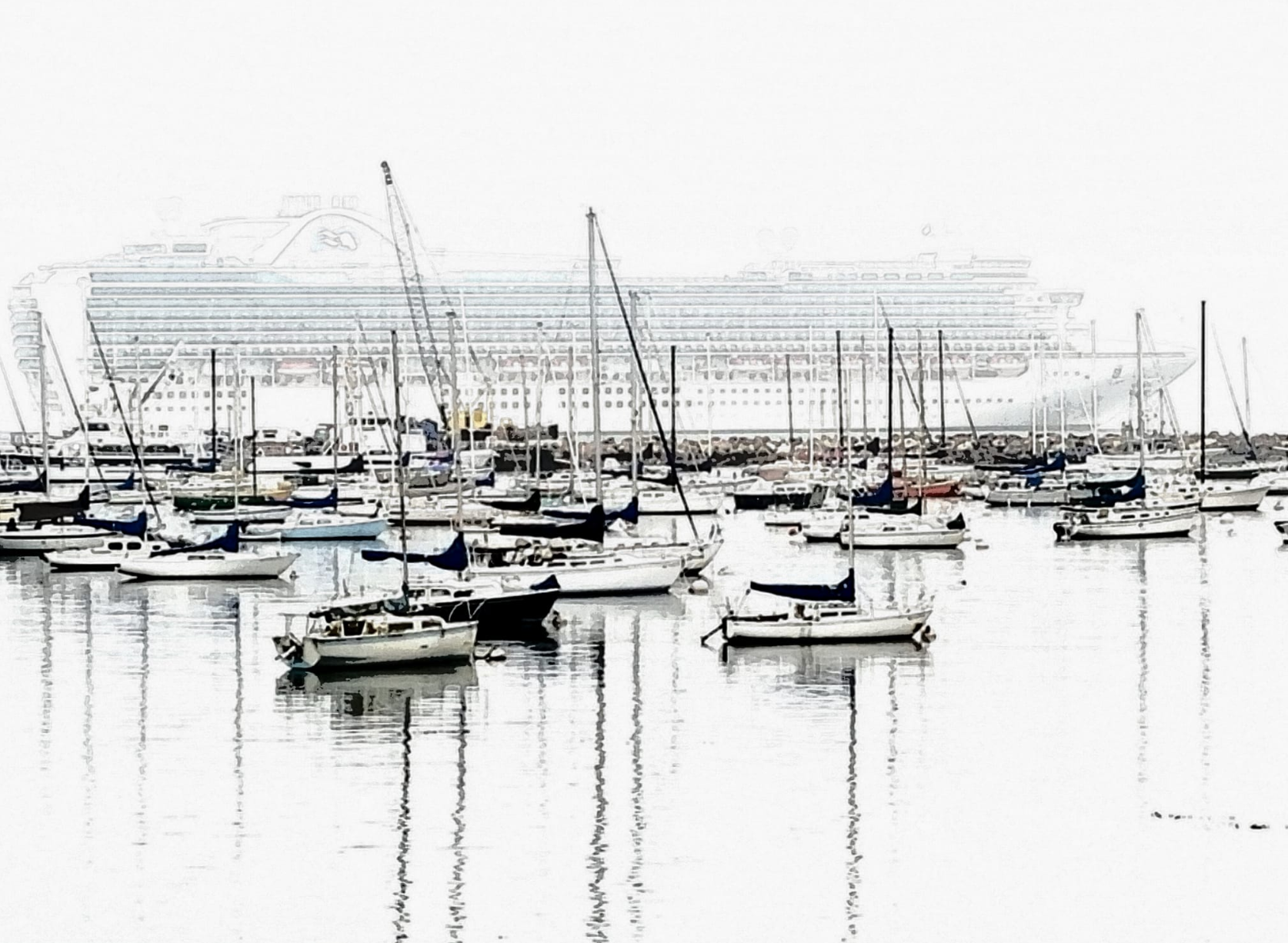A cruise ship in the bay near Monterey | Adobe Stock
By Susan Landry
Seventeen cruise ships carrying approximately 51,000 tourists are set to weigh anchor off the Monterey wharf this year, up from 12 ships in 2018.
That includes the return of a ship from the Crystal Cruises fleet, which was banned from Monterey for 15 years after one of their boats spilled sewage, oily waste and grey water 14 miles off the coast of Big Sur.
In response, protesters are organizing against what they see as an invasion of the Monterey Bay National Marine Sanctuary, a 6,094-square mile federally protected area.
“We just can’t let (Monterey) put us in jeopardy like this. They need to be held accountable,” said Brent Allen, a 53-year-old environmental advocate and standup paddleboard instructor who plays a central role in organizing the protests.
On Feb. 10, activists paddled out to protest the arrival of the 755-foot-long Artania, Monterey’s first cruise ship of 2019. On March 13, when the 113,000 tonnage Ruby Princess was set to anchor, they gathered again for a peaceful demonstration and informative Q&A.
Most recently, the protesters celebrated World Oceans Day on June 8 with a paddle out and cleanup event at Del Monte Beach.
“I think the ideal outcome is that our communities are aware, and our city councils and mayors are communicating effectively,” Allen said.
The movement is quickly gaining steam as a petition to ban cruise lines in Monterey has garnered more than 18,000 signatures. It’s an impressive amount, considering that Monterey has a population of about 28,000.

The city of Monterey quietly approved the increases in nautical tourism, which net a “head tax” of $7 per visitor in docking fees, plus whatever the passengers spend in town — an average of $134 each, according to statements Kim Burton, the former director of community services for Monterey, made to the San Francisco Chronicle.
In 2018, the city brought in $187,859 from the tax. The money is funneled into a Tidelands Trust to be used towards things like wharf repairs, personnel costs for the administration, and security of cruise ship operations, according to a Public Records Act request acquired by Carrie Larssen.
Cruise ships, which can be longer than three football fields, pose risks of air pollution, underwater noise pollution, illegal sewage and grey water dumping, death of marine life, and the possibility of an oil spill.
The cruise ship industry dumps approximately 1 billion gallons of sewage into the ocean each year, based on EPA data compiled by the NGO Friends of the Earth. Because the sewage on cruise lines is diluted with less water when flushed, it is also generally far more concentrated than land-based sources.
The International Maritime Organization, a UN agency responsible for regulating shipping, allows the release of this sewage into the ocean, untreated, so long as it is done at least 12 nautical miles from shore.
As stated on its website, laws in the sanctuary are stricter — all cruise lines entering the area are prohibited from discharging any material other than, “clean vessel engine cooling water, clean vessel generator cooling water, vessel engine or generator exhaust, clean bilge water, or anchor wash.”
In 2003, before this law took effect, the cruise ship Crystal Harmony dumped 36,400 gallons of sewage, oily waste and grey water 14 miles off the coast of Big Sur, violating a contract it signed with the city of Monterey. In response the city issued a 15-year ban on the Crystal Fleet.
Now, with the ban since expired, their cruise ship Crystal Symphony will visit Monterey on June 19 for the second time since last summer.
Another illegal dumping incident in Monterey by the MS Europa in 2017 is currently under investigation with no disciplinary action yet issued. Its sister ship, the MS Amsterdam, will arrive off the Monterey harbor this September.
In 2005, the Monterey Bay National Marine Sanctuary staff, in partnership with the Coast Guard, was granted authority to conduct random inspections of cruise ships anchoring in the sanctuary, according to Scott Kathey, the federal regulatory & enforcement coordinator for the National Oceanic and Atmospheric Administration.
“We do not release inspection reports,” Kathey wrote in an email. “However, the results of any final prosecutorial action would be available to the public,” he said, adding that “no such prosecutions have occurred to date.”
In a private meeting between the activists and NOAA staff, Kathey told the group that all ships are given at least 24 hours notice prior to these “random” inspections, of which there were only three or four last year, said Carrie Larssen, who attended the meeting.
Christine Helm, former chair of the Surfrider Foundation’s Santa Cruz chapter, is joining protesters to demand further action from the city and oversight committees to protect Monterey Bay.
“It’s kind of like tourism versus clean water,” she said at the most recent demonstration. “That’s what we’re dealing with here.”
Noise pollution is another major concern for organizers. Because marine animals including whales, dolphins, turtles, fish, and invertebrates rely on sound for survival, human-created noise can disrupt their ability to hunt, forage, reproduce, and communicate with one another, even leading to permanent tissue damage and hearing loss, according to the Monterey Bay National Marine Sanctuary website.
The sanctuary is of particular concern as it is home to about a fifth of California’s endangered and threatened species, including humpback and blue whales.
“Take a headset, blast the loudest metal music and see how long you can take it,” Allen said. “That’s what’s happening to these animals underwater.”
The Monterey harbor area has no plug-in site for cruise lines. This means that anchored ships must run engines for the entirety of their stay in the water, creating noise and harmful air emissions.
State law requires cruise ships to switch to cleaner-burning fuels when entering territorial waters. However, according to reporting by Vox, many ships attempt to circumvent pollution laws by installing “emission cheat systems” rather than investing in safer, more expensive fuels.
At the most recent demonstration, organizer Tyler Fox, founder of Santa Cruz Waves magazine, pointed out that these emissions flow directly into the city, over schools and other vulnerable populations, urging the community to step up to protect the area.
“There’s no magical force-field around this beauty,” Fox said. “We can’t take it for granted.”
Despite the protesters calls to action, the city of Monterey is moving full steam ahead with 20 cruise ships already on the docket for 2020.
Two days ahead of Crystal Symphony’s scheduled arrival, the city of Monterey is hosting a public information session to discuss cruise ships in the marine sanctuary. The meeting is scheduled from 6-8 p.m. June 17 at the Monterey Conference Center. The session will include a presentation and public Q&A with representatives from the city of Monterey, NOAA, the U.S. Coast Guard, California State Lands Commission, the California Department of Fish and Wildlife, and the San Francisco Bar Pilots Association.
n For more information on upcoming demonstrations, visit @cruiseship_cruisehome on Instagram.
An earlier version of this story first appeared at The Cabrillo Voice.

Have something to say about this story? Send us a letter.